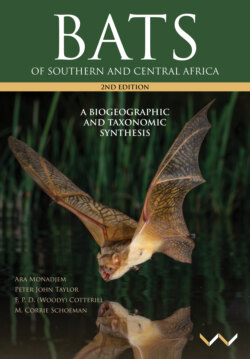Читать книгу Bats of Southern and Central Africa - Ara Monadjem - Страница 31
На сайте Литреса книга снята с продажи.
GEOLOGY
ОглавлениеThe geology of a continent has a profound influence on the living organisms that have evolved across its landscapes. Local and regional geological controls on the composition of Africa’s bat faunas provide many textbook examples of this relationship. For example, the distributions of rupicolous and cavernicolous species are associated closely with particular formations of granites, sandstones and limestones that have crevices and caves eroded and weathered into these rocks (Figure 19). The geomorphology of the landscape plays an equally significant role, as such caves and crevices tend to be clustered along cliffs and scarps. In recent times, mining activity has influenced bat roost availability, especially in the gold-rich contact zones of the granite-greenstone belts. These artificial cavities are of great significance to many cavernicolous bat species. Numerous mining shafts and adits have been sunk over the past few centuries at many sites in Namibia, central Zimbabwe, South Africa, Zambia and the southern Democratic Republic of the Congo (DRC).
This overview of the formative events that forged the southern portion of the African continent singles out formations and events that bear directly on the composition of the regional bat fauna, especially rock formations that provide daylight roosts for cavernicolous and rupicolous species. Unless specifically referenced, the remainder of this section draws on syntheses of knowledge of the geology of South Africa, Lesotho and Eswatini (McCarthy and Rubidge 2005, Johnson et al. 2006), Namibia (Miller 2008) and Zimbabwe (Stagman 1978). The geology of Angola, the Congo basin, Botswana, Malawi, Mozambique and Zambia awaits deserving synthesis, with relevant knowledge scattered widely through the primary literature and in the less accessible in-house reports of mining companies.
